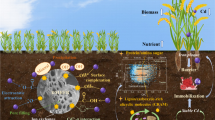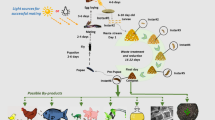Abstract
In this study, the effect of earthworms on microbial features during vermicomposting of pelletized dewatered sludge (PDS) was investigated through comparing two degradation systems with and without earthworm E isenia fetida involvement. After 60 days of experimentation, a relatively stable product with low organic matter and high nitrate and phosphorous was harvested when the earthworms were involved. During the process, earthworms could enhance microbial activity and biomass at the initial stage and thus accelerating the rapid decomposition of PDS. The end products of vermicomposting allowed the lower values of bacterial and eukaryotic densities comparison with those of no earthworm addition. In addition, the presence of earthworms modified the bacterial and fungal diversity, making the disappearances of some pathogens and specific decomposing bacteria of recalcitrant substrates in the vermicomposting process. This study evidences that earthworms can facilitate the stabilization of PDS through modifying microbial activity and number and community during vermicomposting.



Similar content being viewed by others
References
Achenbach LA, Michaelidou U, Bruce RA, Fryman J, Coates JD (2001) Dechloromonas agitata gen. nov., sp. nov. and Dechlorosoma suillum gen. nov., sp. nov., two novel environmentally dominant (per) chlorate-reducing bacteria and their phylogenetic position. Int J Syst Evol Microbiol 51:527–533
Aira M, Monroy F, Domínguez J (2007) Earthworms strongly modify microbial biomass and activity triggering enzymatic activities during vermicomposting independently of the application rates of pig slurry. Sci Total Environ 385:252–261
Aira M, Monroy F, Domínguez J (2009) Changes in bacterial numbers and microbial activity of pig slurry during gut transit of epigeic and anecic earthworms. J Hazard Mater 162:1404–1407
Arora S, Rajpal A, Bhargava R, Pruthi V, Bhatia A, Kazmi AA (2014) Antibacterial and enzymatic activity of microbial community during wastewater treatment by pilot scale vermifiltration system. Bioresour Technol 166:132–141
Benitez E, Nogales R, Elvira C, Masciandaro G, Ceccanti B (1999) Enzyme activities as indicators of the stabilization of sewage sludges composting with Eisenia foetida. Bioresour Technol 67:297–303
Bhat SA, Singh J, Vig AP (2013) Vermiremediation of dyeing sludge from textile mill with the help of exotic earthworm Eisenia fetida Savigny. Environ Sci Pollut Res 20:5975–5982
Bonkowski M, Schaefer M (1997) Interactions between earthworms and soil protozoa: a trophic component in the soil food web. Soil Biol Biochem 29:499–502
Brito-Vega H, Espinosa-Victoria D (2009) Bacterial diversity in the digestive tract of earthworms (Oligochaeta). J Biol Sci 9:192–199
Castillo JM, Romero E, Nogales R (2013) Dynamics of microbial communities related to biochemical parameters during vermicomposting and maturation of agroindustrial lignocellulose wastes. Bioresour Technol 146:345–354
Chen XM, Huang K, Fu XY, Ni SR (2010) Comparative studies on vermicomposting of sewage sludge with two epigeic earthworms. Environmental Science 31:1274–1279 (In Chinese)
Curry JP, Schmidt O (2007) The feeding ecology of earthworms—a review. Pedobiologia 50:463–477
Edwards CA, Fletcher KE (1988) Interactions between earthworms and microorganisms in organic-matter breakdown. Agric Ecosyst Environ 24:235–247
Fernández-Gómez MJ, Nogales R, Insam H, Romero E, Goberna M (2010) Continuous-feeding vermicomposting as a recycling management method to revalue tomato-fruit wastes from greenhouse crops. Waste Manag 30:2461–2468
Fu XY, Huang K, Chen XM, Li FS, Cui GY (2015a) Feasibility of vermistabilization for fresh pelletized dewatered sludge with earthworms Bimastus parvus. Bioresour Technol 175:646–650
Fu XY, Huang K, Cui GY, Chen XM, Li FS, Zhang XY, LI F (2015b) Dynamics of bacterial and eukaryotic community associated with stability during vermicomposting of pelletized dewatered sludge. Int Biodeterior Biodegrad 104:452–459
Gómez-Brandón M, Aira M, Lores M, Domínguez J (2011) Epigeic earthworms exert a bottleneck effect on microbial communities through gut associated processes. PLoS ONE 6, e24786
Gómez-Brandón M, Lores M, Domínguez J (2013) Changes in chemical and microbiological properties of rabbit manure in a continuous-feeding vermicomposting system. Bioresour Technol 128:310–31
Gupta R, Garg VK (2008) Stabilization of primary sewage sludge during vermicomposting. J Hazard Mater 153:1023–1030
Horn MA, Drake HL, Schramm A (2006) Nitrous oxide reductase genes (nosZ) of denitrifying microbial populations in soil and the earthworm gut are phylogenetically similar. Appl Environ Microbiol 72:1019–1026
Huang K, Li FS, Wei YF, Chen XM, Fu XY (2013) Changes of bacterial and fungal community compositions during vermicomposting of vegetable wastes by Eisenia foetida. Bioresour Technol 150:235–241
Jiang C-H, Wang C, Gao F-X, Sun Z-J (2012) Antibacterial immunity system of earthworm. Acta Ecologiae Animalis Domastici 33:6–12 (in Chinese)
Khwairakpam M, Bhargava R (2009) Vermitechnology for sewage sludge recycling. J Hazard Mater 161:948–954
Lazcano C, Gómez-Brandón M, Domínguez J (2008) Comparison of the effectiveness of composting and vermicomposting for the biological stabilization of cattle manure. Chemosphere 72:1013–1019
Liu J, Lu ZB, Yang J, Xing MY, Yu F, Guo MT (2012) Effect of earthworms on the performance and microbial communities of excess sludge treatment process in vermifilter. Bioresour Technol 117:214–221
Matsunaga K, Kubota K, Harada H (2014) Molecular diversity of eukaryotes in municipal wastewater treatment processes as revealed by 18S rRNA gene analysis. Microbes Environ 29:401–407
MEP-Ministry of Environmental Protection of the People’s Republic of China (2012) Soil-determination of ammonium, nitrite and nitrate by extraction with potassium chloride solution-spectrophotometric methods. Beijing, China (in Chinese)
MOHURD-Ministry of Housing and Urban–Rural Development of the People’s Republic of China (2005) Determination method for municipal sludge in wastewater treatment plant. Beijing, China (in Chinese)
MOHURD-Ministry of Housing and Urban–Rural Development of the People’s Republic of China (2012) China’s urban drainage and sewage treatment. Bulletin, 1–17
Moody SA, Briones MJI, Piearce TG, Dighton J (1995) Selective consumption of decomposing wheat straw by earthworms. Soil Biol Biochem 27:1209–1213
Pižl V, Nováková A (2003) Interactions between microfungi and Eisenia andrei (Oligochaeta) during cattle manure vermicomposting: The 7th international symposium on earthworm ecology, Cardiff, Wales 2002. Pedobiologia 47:895–899
Ravindran B, Contreras-Ramos SM, Sekaran G (2015) Changes in earthworm gut associated enzymes and microbial diversity on the treatment of fermented tannery waste using epigeic earthworm Eudrilus eugeniae. Ecol Eng 74:394–401
Sen B, Chandra TS (2009) Do earthworms affect dynamics of functional response and genetic structure of microbial community in a lab-scale composting system? Bioresour Technol 100:804–811
Sen B, Hamelin J, Bru‐Adan V, Godon JJ, Chandra TS (2008) Structural divergence of bacterial communities from functionally similar laboratory‐scale vermicomposts assessed by PCR‐CE‐SSCP. J Appl Microbiol 105:2123–2132
Suthar S, Singh S (2008) Feasibility of vermicomposting in biostabilization of sludge from a distillery industry. Sci Total Environ 394:237–243
Tao J, Chen X, Liu M, Hu F, Griffiths B, Li H (2009) Earthworms change the abundance and community structure of nematodes and protozoa in a maize residue amended rice–wheat rotation agro-ecosystem. Soil Biol Biochem 41:898–904
Valembois P, Roch P, Lassegues M, Cassand P (1982) Antibacterial activity of the hemolytic system from the earthworm Eisenia fetida andrei. J Invertebr Pathol 40:21–27
Vig AP, Singh J, Wani SH, Dhaliwal SS (2011) Vermicomposting of tannery sludge mixed with cattle dung into valuable manure using earthworm Eisenia fetida (Savigny). Bioresour Technol 102:7941–7945
Vivas A, Moreno B, Garcia-Rodriguez S, Benítez E (2009) Assessing the impact of composting and vermicomposting on bacterial community size and structure, and microbial functional diversity of an olive-mill waste. Bioresour Technol 100:1319–1326
Weon HY, Kim BY, Lee CM, Hong SB, Jeon YA, Koo BS, Kwon SW (2009) Solitalea koreensis gen. nov., sp. nov. and the reclassification of [Flexibacter] canadensis as Solitalea canadensis comb. nov. Int J Syst Evol Microbiol 59:1969–1975
Wu JS (2006) Method of determination of soil microbial biomass and its applications. China Meteorological Press, Beijing (in Chinese)
Xing MY, Lv BY, Zhao CH, Yang J (2014) Towards understanding the effects of additives on the vermicomposting of sewage sludge. Environ Sci Pollut Res 22:4644–4653
Yadav A, Garg VK (2009) Feasibility of nutrient recovery from industrial sludge by vermicomposting technology. J Hazard Mater 168:262–268
Yang J, Lv BY, Zhang J, Xing MY (2014) Insight into the roles of earthworm in vermicomposting of sewage sludge by determining the water-extracts through chemical and spectroscopic methods. Bioresour Technol 154:94–100
Yang G, Zhang G, Wang H (2015) Current state of sludge production, management, treatment and disposal in China. Water Res 78:60–73
Yasir M, Chung EJ, Song GC, Bibi F, Jeon CO, Chung YR (2011) Chitinophaga eiseniae sp. nov., isolated from vermicompost. Int J Syst Evol Microbiol 61:2373–2378
Zhang T, Shao MF, Ye L (2011) 454 Pyrosequencing reveals bacterial diversity of activated sludge from 14 sewage treatment plants. ISME J 6:1137–114
Acknowledgments
This work was supported by the National Natural Science Foundation of China (51168029).
Author information
Authors and Affiliations
Corresponding authors
Additional information
Responsible editor: Philippe Garrigues
Electronic supplementary material
Below is the link to the electronic supplementary material.
ESM 1
(DOCX 12 kb)
Rights and permissions
About this article
Cite this article
Fu, X., Cui, G., Huang, K. et al. Earthworms facilitate the stabilization of pelletized dewatered sludge through shaping microbial biomass and activity and community. Environ Sci Pollut Res 23, 4522–4530 (2016). https://doi.org/10.1007/s11356-015-5659-0
Received:
Accepted:
Published:
Issue Date:
DOI: https://doi.org/10.1007/s11356-015-5659-0




